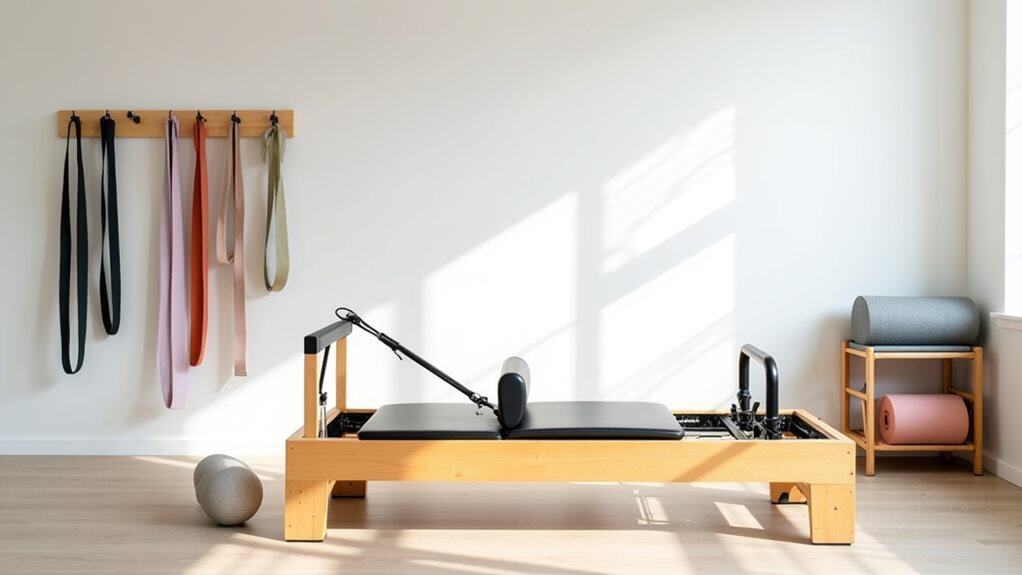Are you looking for a way to get in shape with minimal equipment? Resistance band workouts are an excellent choice. They provide both an effective and efficient workout, allowing you to target and strengthen specific muscles with minimal risk of injury.
But how effective are resistance band workouts, really?
Resistance band workouts can be highly effective in building strength, increasing flexibility, and improving overall fitness. Resistance bands provide resistance throughout the entire range of motion, targeting specific muscle groups and allowing for a full body workout. Additionally, they are portable and can be used anywhere, making them a great option for at-home workouts or travel.
In this article, we’ll take a closer look at the benefits of resistance band workouts and how they can help you reach your fitness goals. We’ll explore the different types of exercises that can be done using resistance bands and what results you can expect from regularly incorporating them into your routine.
What Are Resistance Bands?
Resistance bands are like a secret weapon for the fitness enthusiast. They may look like something you’d find in a children’s toy box, but don’t let their playful appearance fool you.
These elastic bands offer an incredible stretching technique and provide muscle activation to help you reach your goals. Using resistance bands is an effective way to gain strength, boost flexibility and increase mobility.

Not only do they allow you to target specific muscles from different angles, but they also add variety to your workouts. The tension of the bands can be adjusted to match your level of fitness, enabling you to challenge yourself no matter what your ability level is.
With the right approach and commitment, resistance band workouts can be a great addition to any training routine. Whether it’s increasing muscle tone or improving overall strength, these versatile tools are an excellent choice for anyone looking to take their fitness journey up a notch.
Moving forward, let’s explore some of the benefits of incorporating resistance band exercises into your workout regimen.
Benefits Of Resistance Band Workouts
You’ll definitely experience increased strength with regular resistance band workouts.
Not only will it help to build muscle, but it’ll also help improve your flexibility.
So don’t be surprised if you start feeling more limber and agile!
It’s a great way to get a full-body workout without having to use weights or equipment.
Increasing Strength
Resistance band workouts are an amazing way to increase your strength, building stamina and improving balance. They can be done from the comfort of your own home or gym, in a group class or with a personal trainer. And with endless variations available, there’s something for everyone!
With resistance bands, you’ll start to see results quickly, and be able to take the next step in strengthening your body. As you become more confident in your movements, you can increase the intensity of the workout and develop more muscular endurance.
Resistance bands help you move through all planes of motion, training not only your muscles but also improving stability and coordination. Not only that, they provide an effective full-body workout that doesn’t require any expensive equipment — just a few lightweight bands will do!
So don’t wait any longer; start using resistance bands today and reap the benefits of increased strength and improved balance!
Improving Flexibility
Resistance band workouts not only help to increase strength and stability, but they can also be beneficial for improving flexibility. With the right stretching techniques and body mechanics, you can work to lengthen your muscles and improve mobility.
Unlike traditional stretching movements, resistance bands allow you to isolate specific muscles and get a deeper stretch than ever before. This can help to reduce injury risk and improve posture by unlocking areas of tightness or tension in your body.
By incorporating resistance bands into your regular routine, you’ll be able to use them as an active form of stretching that challenges your range of motion while activating more muscles along the way. Not only will this help to extend your flexibility, but it’ll also give you a chance to work on core strength at the same time!
You’ll be amazed how much better you feel after just a few minutes of banded stretches — feeling energized, relaxed and ready for whatever comes next.
So what are you waiting for? Get out those resistance bands and start boosting your flexibility today! With regular use, you’ll soon find yourself moving with ease so that you can tackle any physical challenge with confidence.
Types Of Resistance Band Exercises
Resistance band workouts offer a wide range of exercises that can be tailored to your fitness goals. Whether you’re looking to tone and strengthen your muscles or increase your flexibility, these bands provide an effective and versatile way to do it.
From stretching techniques to variable tension exercises, the possibilities are endless when it comes to resistance band workouts. Here’s a list of 3 great exercises you can do with resistance bands:
Bicep Curls
Chest Presses
Squats
When done correctly, resistance band workouts are an effective way to challenge your body and reach new levels of strength and flexibility. As with any workout program, it is important to be mindful of correct form and posture when performing these exercises – bad habits can lead to injuries or even setbacks in progress!
With this in mind, let’s look at some guidelines for safely incorporating resistance band workouts into your routine.
Guidelines For Resistance Band Workouts
Yes, resistance band workouts can be highly effective for building strength and muscle.
To make sure you are getting the most out of your workouts, it is important to follow some key guidelines.
Moderating intensity is key; while it is important to challenge yourself with each resistance band workout, it is also important not to overdo it. Too much intensity too soon can lead to injury and reduce the effectiveness of your workouts.
Tracking progress is also essential in making sure you’re getting the most from your resistance band workouts. Keeping track of how many reps or sets you do each time will help keep you motivated and give you a tangible way to measure your progress as you get stronger.
Additionally, tracking how much rest you take between sets and how long your entire workout lasts can help ensure that you’re challenging yourself without overdoing it.
Resistance band workouts can be incredibly effective when done correctly. By moderating intensity and tracking progress, you’ll be able to maximize the benefits of every workout and continue building strength and muscle efficiently and safely.
With an understanding of these guidelines, you’re now ready to start developing a resistance band workout routine that will work best for your fitness goals.
Developing A Resistance Band Workout Routine
A popular fitness adage states, “It’s not how hard you work, but how smart you work that matters.” This rings especially true when it comes to resistance band workouts.
To get the most out of your routine, it is essential to understand the basics of stretching techniques and progressive overload.
The key to any successful resistance band workout is good form. Using proper technique will ensure that you are targeting the right muscles and getting the most out of each exercise.
Start with a light tension band and gradually increase the difficulty as your strength improves. The idea is to progressively overload your muscles and give them time to rest between sets.
By focusing on proper form and utilizing progressive overload, you can maximize the effectiveness of each workout and track your progress over time.
With dedication and consistency, you will begin to see results in no time! Looking ahead, we will explore further how we can target different muscle groups through a variety of exercises.
Targeting Different Muscle Groups
Resistance band workouts are an effective way to target different muscle groups in the body. They provide a full-body workout that can be adjusted to suit any fitness level and goal.
From toning arms to targeting lower body, resistance bands offer a range of benefits:
- Versatility: Resistance bands are versatile tools that can be used anywhere – at home, outdoors, or in the gym. You don’t need any special equipment or machines.
- Budget-friendly: Resistance bands are inexpensive and cost-effective compared to other exercise equipment like dumbbells or weight machines.
- Variety of exercises: With resistance bands, you can do many different exercises that target various muscle groups and areas of the body.
- Customizable: The tension on the band can be varied for more challenging workouts as your strength increases over time.
The key is finding ways to challenge yourself with resistance bands by increasing difficulty and complexity of movements – this will help you reach your fitness goals faster!
With the right technique and effort, you can use resistance bands to tone and sculpt your entire body. So get creative and start experimenting with different exercises today!
Increasing Resistance Band Difficulty
As you progress in your resistance band workouts, it’s important to remember to increase the difficulty of your workout. There are several ways to do this and they involve scaling reps, varying tension, and intensifying the exercises you already know.
First, when it comes to scaling reps, the number of repetitions can be increased gradually over time as you become more comfortable with a particular exercise. For example, if you’re doing a bicep curl with a resistance band, start with 10-12 repetitions and slowly increase the number of reps over time as you gain strength.
Second, varying tension is another way to intensify your workout. You can do this by either increasing or decreasing the tension on the resistance band itself or by using bands with different levels of resistance. For instance, if you’re doing triceps extensions with a light resistance band, try switching to a heavier one for more intensity.
Finally, there are many more advanced exercises that can be added to your routine once you become comfortable with the basics. These exercises will not only help strengthen specific areas of your body but also challenge your coordination and balance while providing an overall greater intensity level than standard exercises.
| Method | Advantage | |
|---|---|---|
| Scaling Reps | Increase gradually over time Start low and increase reps | More intense workout |
| Varying Tension | Increase/decrease tension on band Use bands with different levels of resistance | Challenging coordination and balance |
| Advanced Exercises | Add once comfortable with basics | Greater intensity level than standard exercises |
By utilizing these three strategies – scaling reps, varying tension and adding advanced exercises – you can ensure that your workouts stay challenging and effective no matter what level of fitness or experience you have. With a little bit of creativity and dedication, anyone can create their own effective at-home workout routine with just some simple resistance bands!
Benefits Of Using Resistance Bands At Home
Resistance bands are an affordable and easy-to-use piece of equipment that can add a new dimension to your home workout. With resistance bands, you can experience the same benefits of weight training without having to invest in a full set of weights.
Here are some of the advantages of using this versatile equipment:
- Portability: Resistance bands are incredibly lightweight and compact, so they’re easy to take with you wherever you go. This means that you can get an effective workout at home, while travelling or even at the office!
- Time flexibility: Unlike time-consuming gym workouts, resistance band exercises can be done quickly and conveniently. They also require minimal setup time, which is perfect if you have a busy lifestyle or limited available time for exercise.
- Versatility: Resistance bands come in a variety of sizes and levels of resistance, so you can customize your workout according to your individual needs and fitness goals. Plus, there are hundreds of different exercises that use resistance bands – from basic stretching routines to advanced strength building drills – so there’s plenty of variety to keep your workouts interesting.
Using resistance bands is an efficient way to stay fit and healthy without spending lots of money on expensive gym equipment or membership fees. Moreover, it’s an excellent way to add variety and challenge to any exercise routine – no matter what level you’re currently at – while still enjoying all the benefits!
With these advantages in mind, it’s clear why many people choose to incorporate resistance bands into their home workouts. As we move on, let us now consider the safety considerations for resistance band training.
Safety Considerations For Resistance Band Training
When selecting a resistance band, it’s important to make sure it’s the right size and tension for your body type and fitness level.
Prior to any workout, it’s essential to prepare your muscles with dynamic stretching and a few warm-up exercises.
When it comes to resistance band training, always start with lighter bands and progress to heavier ones as you become stronger and more conditioned.
When it comes to progressive loading, it’s important to gradually increase the resistance of the band over time to ensure your muscles are adapting and responding to the new stress.
To ensure your safety, always make sure your technique is correct and you’re not overstretching the band too much.
Lastly, listen to your body and don’t be afraid to take a break if you feel any pain or discomfort.
Band Selection
Whether you’re just starting out or already have a few resistance band exercises under your belt, it’s important to take safety into consideration.
One of the most important safety considerations when using resistance bands is selecting the right band for your body mechanics and muscle recruitment needs.
A good way to do this is to choose a band that gives you just enough resistance to challenge yourself without overdoing it.
When selecting the right band for you, keep in mind what kind of exercise you’ll be doing and how much tension the band will need to provide.
If you’re looking for an overall body workout that targets multiple muscle groups, a medium-resistance band will be best suited for your needs.
However, if you want more intense exercises that focus on specific muscles, then a heavy-resistance or even extra-heavy-resistance band may be necessary.
It’s also important to pay attention to the material of the bands you are using as well as their size and length.
Make sure that they are made of strong materials such as latex or rubber, which will help ensure that they don’t break during use, and that they are long enough for whatever exercise you plan on performing with them.
With proper selection, resistance bands can be an effective tool in helping reach your fitness goals – so make sure to choose wisely!
Muscular Preparation
Before beginning any resistance band exercises, it’s important to do some muscular preparation. This will help ensure that your muscles are properly activated and warmed up before you start your workout.
You can do this by doing dynamic stretches or light bodyweight exercises such as squats and lunges to get your muscles ready for the work ahead. Pay attention to the muscles that you’re targeting with each exercise and make sure they’re firing correctly prior to using the resistance bands.
Doing this will minimize muscle fatigue and help you get the most out of your workouts. A few minutes of preparation can go a long way in helping you reach your fitness goals, so take the time to ensure proper muscle activation before moving on with your routine.
Progressive Loading
As an instructor, it’s important to remember that with resistance band training, progressive loading is key. This means slowly increasing the intensity of each exercise over time so that your muscles don’t become too fatigued. By gradually adding more resistance and challenging yourself in increments, you can build strength and endurance while avoiding injury. This approach will also help you progress effectively and reach your desired fitness goals.
It’s also important to consider the amount of tension you’re using when performing resistance band exercises. If the band feels too tight or is causing discomfort, ease off a bit and reduce the intensity of the exercise until it becomes manageable. Remember that for maximum results, you want to challenge yourself without straining too much, as this can lead to muscle fatigue and potential injury.
Incorporating progressive loading into your resistance band workouts will help ensure that you stay safe while still pushing yourself towards your goals. With regular practice, you’ll be able to increase the intensity of each exercise at a steady pace while avoiding any potential injuries along the way!
Tips For Getting The Most Out Of Resistance Band Workouts
Resistance band workouts are an effective and versatile way to create lean muscle, build strength, and maximize gains. But if you don’t do them right, you won’t get the most out of your workouts.
Here are some tips to help you make sure you’re getting the full benefits of your resistance band exercises.
Start each workout with a warm-up that includes dynamic stretching. This will loosen your muscles and help prepare them for the workout ahead.
Additionally, make sure you focus on proper form throughout your routine; this will ensure you get the most out of each exercise and reduce the risk of injury.
Finally, it’s important to challenge yourself regularly by increasing the intensity or duration of your resistance band workouts. Increase either one in small increments over time for the best results.
And remember – consistency is key! If you stick with it, you’ll soon start to see significant gains in strength and muscle tone from doing resistance band exercises.
Conclusion
Resistance band workouts are a great way to enhance your fitness routine. You can use them at home, or take them with you anywhere for an effective workout no matter the location.
When done correctly and safely, resistance bands can help you increase strength, balance and flexibility. Plus, they are easily adjustable so you can tailor the intensity of your workouts to your own individual needs.
My advice? Give resistance band training a try – you won’t regret it! Start with basic movements and gradually increase difficulty as your strength grows.
Think of it like having a personal Pilates instructor in your pocket! With dedication and practice, you will be amazed at what these bands can do for your body – they truly are a gift that keeps on giving!




